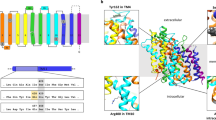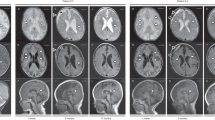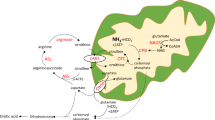Abstract
The actions and the metabolism of thyroid hormone are intracellular events that require the transport of iodothyronines across the plasma membrane. It is increasingly clear that this process does not occur by simple diffusion, but is facilitated by transport proteins. Only recently have iodothyronine transporters been identified at the molecular level, of which organic anion transporting polypeptide 1C1 and monocarboxylate transporter 8 (MCT8) deserve special mention, because of their high activity and specificity for iodothyronines. Organic anion transporting polypeptide 1C1 is almost exclusively expressed in brain capillaries, and may be crucial for the transport of the prohormone T4 across the blood–brain barrier. MCT8 is also expressed in the brain—in particular, in neurons—but also in other tissues. MCT8 seems to be especially important for the uptake of active hormone T3 into neurons, which is essential for optimal brain development. T3 is produced from T4 by type 2 deiodinase in neighboring astrocytes. Neurons express type 3 deiodinase, the enzyme that terminates T3 activity. The SLC16A2 (formerly MCT8) gene is located on chromosome Xq13.2 and has recently been associated with a syndrome combining severe, X-linked, psychomotor retardation and high serum T3 levels. In over 20 families, where affected males have developed this syndrome, several mutations in MCT8 have been identified. The disease mechanism is thought to involve a defect in the neuronal entry of T3 and, therefore, in the action and metabolism of T3 in these cells. This defect results in impaired neurological development and a decrease in T3 clearance.
Key Points
-
Thyroid hormones are extremely important for brain development; neurons are their major target cells
-
Monocarboxylate transporter 8 is essential for uptake of T3 in central neurons and, therefore, for allowing T3 access to its intracellular receptor and to its degrading enzyme D3 in these cells
-
Inactivation of monocarboxylate transporter 8 interferes with the action and metabolism of T3 in neurons and results in impaired neurological development and increased T3 levels
-
Mutation of a thyroid hormone transporter represents a novel mechanism for the pathogenesis of thyroid hormone resistance, which has dramatic consequences
This is a preview of subscription content, access via your institution
Access options
Subscribe to this journal
Receive 12 print issues and online access
$209.00 per year
only $17.42 per issue
Buy this article
- Purchase on Springer Link
- Instant access to full article PDF
Prices may be subject to local taxes which are calculated during checkout




Similar content being viewed by others
References
Bianco AC et al. (2002) Biochemistry, cellular and molecular biology, and physiological roles of the iodothyronine selenodeiodinases. Endocr Rev 23: 38–89
Kohrle J (2002) Iodothyronine deiodinases. Methods Enzymol 347: 125–167
Silva JE (2003) The thermogenic effect of thyroid hormone and its clinical implications. Ann Intern Med 139: 205–213
Morreale de Escobar G et al. (2004) Role of thyroid hormone during early brain development. Eur J Endocrinol 151 (Suppl 3): U25–U37
Bernal J (2002) Action of thyroid hormone in brain. J Endocrinol Invest 25: 268–288
Yen PM (2001) Physiological and molecular basis of thyroid hormone action. Physiol Rev 81: 1097–1142
Bassett JH et al. (2003) Mechanisms of thyroid hormone receptor-specific nuclear and extra nuclear actions. Mol Cell Endocrinol 213: 1–11
Dupre SM et al. (2004) Both thyroid hormone receptor (TR)β1 and TRβ2 isoforms contribute to the regulation of hypothalamic thyrotropin-releasing hormone. Endocrinology 145: 2337–2345
Abel ED et al. (2003) Dominant inhibition of thyroid hormone action selectively in the pituitary of thyroid hormone receptor-β null mice abolishes the regulation of thyrotropin by thyroid hormone. Mol Endocrinol 17: 1767–1776
Maia AL et al. (2005) Type 2 iodothyronine deiodinase is the major source of plasma T3 in euthyroid humans. J Clin Invest 115: 2524–2533
Kester MH et al. (2004) Iodothyronine levels in the human developing brain: major regulatory roles of iodothyronine deiodinases in different areas. J Clin Endocrinol Metab 89: 3117–3128
Baqui M et al. (2003) Human type 3 iodothyronine selenodeiodinase is located in the plasma membrane and undergoes rapid internalization to endosomes. J Biol Chem 278: 1206–1211
Hennemann G et al. (2001) Plasma membrane transport of thyroid hormones and its role in thyroid hormone metabolism and bioavailability. Endocr Rev 22: 451–476
Abe T et al. (2002) Thyroid hormone transporters: recent advances. Trends Endocrinol Metab 13: 215–220
Friesema EC et al. (2005) Thyroid hormone transporters. Vitam Horm 70: 137–167
Jansen J et al. (2005) Thyroid hormone transporters in health and disease. Thyroid 15: 757–768
Friesema EC et al. (1999) Identification of thyroid hormone transporters. Biochem Biophys Res Commun 254: 497–501
Hagenbuch B and Dawson P (2004) The sodium bile salt cotransport family SLC10. Pflugers Arch 447: 566–570
Abe T et al. (1998) Molecular characterization and tissue distribution of a new organic anion transporter subtype (oatp3) that transports thyroid hormones and taurocholate and comparison with oatp2. J Biol Chem 273: 22395–22401
Hagenbuch B and Meier PJ (2003) The superfamily of organic anion transporting polypeptides. Biochim Biophys Acta 1609: 1–18
Pizzagalli F et al. (2002) Identification of a novel human organic anion transporting polypeptide as a high affinity thyroxine transporter. Mol Endocrinol 16: 2283–2296
Sugiyama D et al. (2003) Functional characterization of rat brain-specific organic anion transporter (Oatp14) at the blood–brain barrier: high affinity transporter for thyroxine. J Biol Chem 278: 43489–43495
Tohyama K et al. (2004) Involvement of multispecific organic anion transporter, Oatp14 (Slc21a14), in the transport of thyroxine across the blood–brain barrier. Endocrinology 145: 4384–4391
Friesema EC et al. (2001) Thyroid hormone transport by the heterodimeric human system L amino acid transporter. Endocrinology 142: 4339–4348
Ritchie JW et al. (1999) Thyroid hormone transport by 4F2hc-IU12 heterodimers expressed in Xenopus oocytes. J Endocrinol 163: R5–R9
Friesema EC et al. (2003) Identification of monocarboxylate transporter 8 as a specific thyroid hormone transporter. J Biol Chem 278: 40128–40135
Halestrap AP and Meredith D (2004) The SLC16 gene family—from monocarboxylate transporters (MCTs) to aromatic amino acid transporters and beyond. Pflugers Arch 447: 619–628
Kim DK et al. (2001) Expression cloning of a Na+-independent aromatic amino acid transporter with structural similarity to H+/monocarboxylate transporters. J Biol Chem 276: 17221–17228
Kim do K et al. (2002) The human T-type amino acid transporter-1: characterization, gene organization, and chromosomal location. Genomics 79: 95–103
Lafreniere RG et al. (1994) A novel transmembrane transporter encoded by the XPCT gene in Xq13.2. Hum Mol Genet 3: 1133–1139
Friesema ECH et al. (2004) Functional analysis of missense mutations in the MCT8 T3 transporter in boys with severe psychomotor retardation [abstract]. Thyroid 14: 761
Jansen J et al. (2005) Mutations in the thyroid hormone transporter MCT8 in psychomotor retardation: effects on uptake and metabolism of T3 . Thyroid 15 (Suppl 1): S4
NCBI UniGene: an organized view of the transcriptome [http://www.ncbi.nlm.nih.gov/UniGene] (accessed 29 June 2006)
Alkemade A et al. (2005) Novel neuroanatomical pathways for thyroid hormone action in the human anterior pituitary. Eur J Endocrinol 154: 491–500
Prummel MF et al. (2004) Ultra short-loop feedback control of thyrotropin secretion. Thyroid 14: 825–829
Heuer H et al. (2005) The monocarboxylate transporter 8 linked to human psychomotor retardation is highly expressed in thyroid hormone-sensitive neuron populations. Endocrinology 146: 1701–1706
Alkemade A et al. (2005) Neuroanatomical pathways for thyroid hormone feedback in the human hypothalamus. J Clin Endocrinol Metab 90: 4322–4334
Cavalieri RR et al. (1999) Thyroid hormone export in rat FRTL-5 thyroid cells and mouse NIH-3T3 cells is carrier-mediated, verapamil-sensitive, and stereospecific. Endocrinology 140: 4948–4954
Mitchell AM et al. (2005) Thyroid hormone export from cells: contribution of P-glycoprotein. J Endocrinol 185: 93–98
Refetoff S (2004) Thyroid hormone resistance syndromes. In Thyroid Disease Manager: The Thyroid and its Diseases (Eds DeGroot LJ and Hennemann G) [http://www.thyroidmanager.org/thyroidbook.htm] (accessed 29 June 2006)
Yen PM (2003) Molecular basis of resistance to thyroid hormone. Trends Endocrinol Metab 14: 327–333
Friesema EC et al. (2004) Association between mutations in a thyroid hormone transporter and severe X-linked psychomotor retardation. Lancet 364: 1435–1437
Dumitrescu AM et al. (2004) A novel syndrome combining thyroid and neurological abnormalities is associated with mutations in a monocarboxylate transporter gene. Am J Hum Genet 74: 168–175
Maranduba CM et al. (2006) Decreased cellular uptake and metabolism in Allan–Herndon–Dudley syndrome (AHDS) due to a novel mutation in the MCT8 thyroid hormone transporter. J Med Genet 43: 457–460
Schwartz CE et al. (2005) Allan–Herndon–Dudley syndrome and the monocarboxylate transporter 8 (MCT8) gene. Am J Hum Genet 77: 41–53
Holden KR et al. (2005) X-linked MCT8 gene mutations: characterization of the pediatric neurologic phenotype. J Child Neurol 20: 852–857
Herzovich V et al. (2005) A novel mutation in a thyroid hormone transporter gene (MCT8) associated with neurological damage and high levels of serum T3 [abstract]. Thyroid 15 (Suppl 1): S226
Lenzner S et al. (2004) Severe X-linked mental retardation caused by mutations in the gene for the thyroid hormone transporter MCT8 [abstract C32]. In European Human Genetics Conference: 2004 June 12–15; Munich. [http://www.abstractsonline.com/viewer/SearchResults.asp] (accessed 29 June 2006)
Brockmann K et al. (2005) X-linked paroxysmal dyskinesia and severe global retardation caused by defective MCT8 gene. J Neurol 252: 663–666
Allan W et al. (1944) Some examples of the inheritance of mental deficiency: apparently sex-linked idiocy and microcephaly. Am J Mental Defic 48: 325–334
Schwartz CE et al. (1990) Allan–Herndon syndrome. II. Linkage to DNA markers in Xq21. Am J Hum Genet 47: 454–458
Stevenson RE et al. (1990) Allan–Herndon syndrome. I. Clinical studies. Am J Hum Genet 47: 446–453
Zorick TS et al. (2004) Fine mapping and clinical reevaluation of a Brazilian pedigree with a severe form of X-linked mental retardation associated with other neurological dysfunction. Am J Med Genet A 127: 321–323
Bianco AC and Larsen PR (2005) Cellular and structural biology of the deiodinases. Thyroid 15: 777–786
Pugeat M et al. (1996) Clinical utility of sex hormone-binding globulin measurement. Horm Res 45: 148–155
Pascal N et al. (2002) Serum concentrations of sex hormone binding globulin are elevated in kwashiorkor and anorexia nervosa but not in marasmus. Am J Clin Nutr 76: 239–244
Vierhapper H et al. (1999) Increase in serum concentrations of thyroxine-binding globulin and of cortisol-binding globulin after the induction of normal thyroid function in previously hyperthyroid patients. Thyroid 9: 1085–1087
Klein I and Ojamaa K (2001) Thyroid hormone and the cardiovascular system. N Engl J Med 344: 501–509
Kahaly GJ and Dillmann WH (2005) Thyroid hormone action in the heart. Endocr Rev 26: 704–728
Friedrichsen S et al. (2003) Regulation of iodothyronine deiodinases in the Pax8−/− mouse model of congenital hypothyroidism. Endocrinology 144: 777–784
Acknowledgements
Our thanks go to all families and collaborators who contributed their efforts towards this work. These studies were supported by grants to ECH Friesema from the Netherlands Organization of Scientific Research, to J Jansen from the Sophia Children's Hospital Foundation for Medical Research, and to H Heuer from the American Thyroid Association.
Author information
Authors and Affiliations
Corresponding author
Ethics declarations
Competing interests
The authors declare no competing financial interests.
Rights and permissions
About this article
Cite this article
Friesema, E., Jansen, J., Heuer, H. et al. Mechanisms of Disease: psychomotor retardation and high T3 levels caused by mutations in monocarboxylate transporter 8. Nat Rev Endocrinol 2, 512–523 (2006). https://doi.org/10.1038/ncpendmet0262
Received:
Accepted:
Issue Date:
DOI: https://doi.org/10.1038/ncpendmet0262
This article is cited by
-
Role and Clinical Significance of Monocarboxylate Transporter 8 (MCT8) During Pregnancy
Reproductive Sciences (2023)
-
A novel variant in SLC16A2 associated with typical Allan-Herndon-Dudley syndrome: a case report
BMC Pediatrics (2022)
-
Congenital hypothyroidism
Orphanet Journal of Rare Diseases (2010)
-
Thyroid hormone transporters in the brain
The Cerebellum (2008)
-
MCT8 mutation analysis and identification of the first female with Allan–Herndon–Dudley syndrome due to loss of MCT8 expression
European Journal of Human Genetics (2008)



